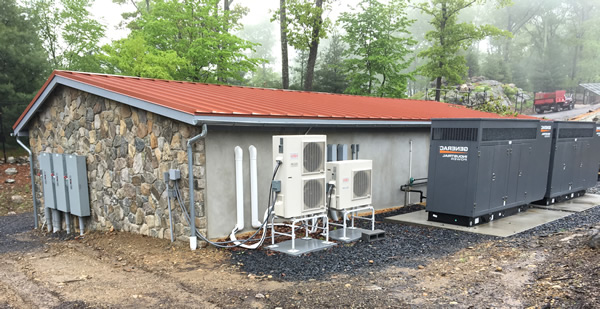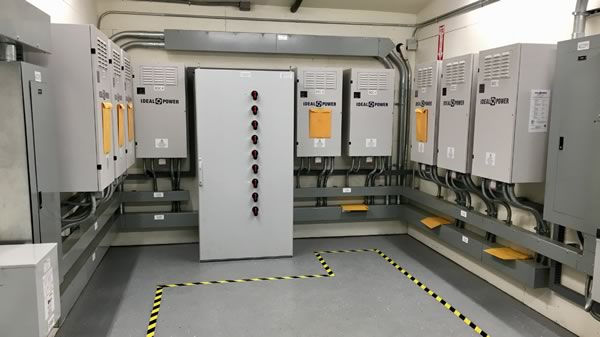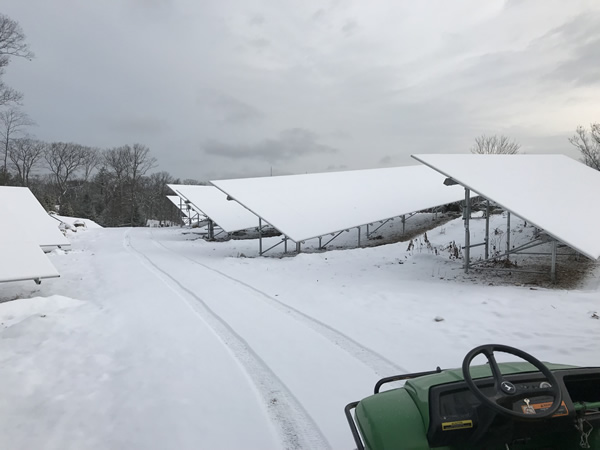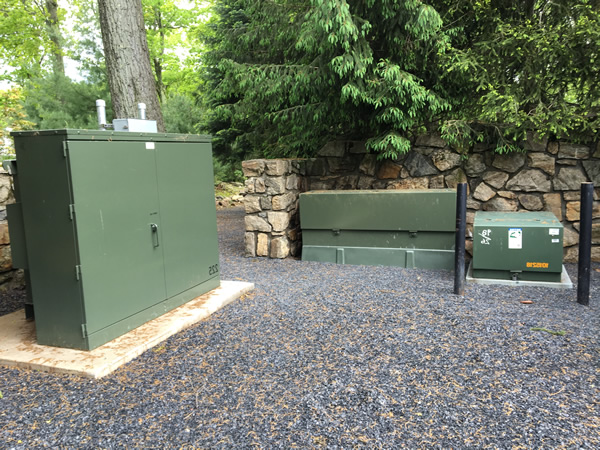 Nestled in the Catskills there’s a new microgrid that defies the usual value propositions. It’s an outlier of a project because microgrids are normally built for different reasons – to bring power in developing countries to people who depend on unreliable or non-existent grid infrastructure; to save on delivering expensive diesel fuel to islands or other remote locations; or to save on corporate energy costs – to mention just a few.
Nestled in the Catskills there’s a new microgrid that defies the usual value propositions. It’s an outlier of a project because microgrids are normally built for different reasons – to bring power in developing countries to people who depend on unreliable or non-existent grid infrastructure; to save on delivering expensive diesel fuel to islands or other remote locations; or to save on corporate energy costs – to mention just a few.
So why is this microgrid here? It represents an interesting choice in the diverse and growing portfolio of energy options by its early-adopting owner, an business entrepreneur with an engineering background. He wanted to substantially upgrade his electric service, but he also wanted to reduce his carbon emissions. When the utility company quoted him a substantial cost to upgrade the electric service, he decided to go off the grid instead. For less money, higher reliability, and higher survivability. This microgrid represents a private investment by someone who is attracted to energy innovation and who has the resources to explore the boundaries of contemporary technology. At the same time, he’s a savvy manager of costs, and wanted to get the most out of his investment.
 What Does a Private Microgrid Look Like?
What Does a Private Microgrid Look Like?
In order to create the ultimate personal microgrid, you could start – as this microgrid investor did – with about 60 acres of land, a load derived from 15,000 square feet of housing and event space, and several large outbuildings and guest houses, plus multiple swimming pools and other recreational amenities.. You might also want access to super fast charging for multiple Tesla electric vehicles that may visit the property from time to time.
This is exactly the setup that Marc Lopata encountered when approached by Wright Architects, the Owner’s Agent for the property owner. Wright called Azimuth Energy, asking for help in designing an off-grid hybrid renewable energy system, and making sense of the “wild west” they saw as the microgrid marketplace. “This was an unusual request,” said Lopata, “but a great challenge and a very interesting project. We are used to designing solar-storage microgrids for privately owned islands in the Caribbean, but we welcomed the challenge of the different climate, soil conditions, load profile, and solar resource.
“We modeled the microgrid system in HOMER Pro. That made it easy to present the project, clearly portray some of its complex engineering features and benefits to the client, and sell the merits of our approach. We often use HOMER not only as an engineering tool, but also as a business development platform.”
 Engineering started in the spring of 2017, construction began in October of 2017, and this microgrid in the Catskills has been fully operational for about two months. It includes a new 4,160 VAC distribution system on the property (the original distribution system was a split-phase 120/240 VAC grid more typical for residential neighborhoods).
Engineering started in the spring of 2017, construction began in October of 2017, and this microgrid in the Catskills has been fully operational for about two months. It includes a new 4,160 VAC distribution system on the property (the original distribution system was a split-phase 120/240 VAC grid more typical for residential neighborhoods).
The new private medium-voltage grid was necessary to distribute power produced on the site. “We elected to do it at medium voltage to reduce the line losses and the construction costs,” says Lopata, explaining that the medium voltage allowed them to use the existing conduit and avoid any more excavation in the rocky ground.
There’s a set of liquid propane generators that are sized to run 30% of the time, a 300 kW fixed-tilt PV array, 650 kWh of Samsung lithium-ion batteries and banks of Ideal Power Systems bi-directional converters (BDC’s) in a DC-coupled architecture.
The sizing and configuration of these energy resources were based on the original HOMER Pro modeling, which identified the lowest cost of energy (Levelized Cost of Energy or LCOE). But, as the owner considers an upgrade, other factors will enter into the design decisions.
Currently, dispatch of the batteries, which can supply backup power for about a day, are managed by an Elm FieldSight Microgrid Controller. Typically, the site controller starts discharging batteries in the late afternoon when the solar array stops producing. The battery plant can provide about a day of backup, if needed.
“In the beginning we just estimated the load,” says Lopata. “It was pretty complicated because of all the buildings. Now we’ll have much better load data for planning the upgrade to the system.”
 The microgrid equipment is installed in a dedicated powerhouse. The powerhouse was designed and constructed by Wright Architects, with architectural features to suit the property. The building has abundant interior space for expansion, and climate control for the microgrid equipment, as well as small UPS to power the site controller in the event of a black-start condition. Azimuth always includes a small UPS, based on previous projects that have been left “in the dark” without being able to power up.
The microgrid equipment is installed in a dedicated powerhouse. The powerhouse was designed and constructed by Wright Architects, with architectural features to suit the property. The building has abundant interior space for expansion, and climate control for the microgrid equipment, as well as small UPS to power the site controller in the event of a black-start condition. Azimuth always includes a small UPS, based on previous projects that have been left “in the dark” without being able to power up.
How to Design a Personal Microgrid – Energy Efficiency First
Before adding new renewable resources on the property, the Wright team worked hard to improve energy efficiency. Andrew Wright, President of Wright Architects, offers that, “the property owner is very conscious of his carbon footprint and strives to minimize it however possible. Energy efficiency is a clear and proven way to do that.”
In order to optimize a project such as this economically, it’s crucial to wring maximum benefits out of energy efficiency improvements. Despite its lowly status as the least glamorous of energy upgrades, energy efficiency provides the best return on investment. Lopata says, “Energy efficiency always makes sense because you are reducing your operating expenses. But if you’re building a microgrid, efficiency makes even more sense financially because you can reduce the size of the microgrid as well as your capital investments in energy generation resources.”
This microgrid’s energy efficiency improvements included the addition of two ground source heat pumps for the HVAC system – that should keep the buildings warm in winter and cool in summer. There’s also a solar-thermal system that heats water for the pool and hot water for the buildings.

Microgrid Upgrades Planned
Lopata says “As part of the initial goal-setting exercise, a ‘design charette’ if you will, the overall power plant was modeled in HOMER Pro to deliver the lowest-cost-of-energy (LCOE) option. That typically results in the generators running about 30% of the time. The plant does indeed work as engineered.
Now the microgrid owner is ready to upgrade the system. He wants to reduce his fossil-fuel consumption as much as he can. Following a new goal-setting discussion, the new performance target for the microgrid is to avoid using the generators at all during the summer months.
The solar system is performing so well that the inverters are curtailing some of the power in the summer. Lopata points out that “this happens in every microgrid when you design for the lowest cost of energy. At times the generating capacity will exceed the load when the batteries are fully charged. That presents a great opportunity to store more energy in batteries.”
This next phase will add more solar PV and battery resources, including more BDC’s as determined by the HOMER modeling, according to Lopata. “We will rerun the model and instead of aiming for the lowest costs of energy, we will aim for no generator run time during the summer. HOMER will show us how to do that, and with a year of load data, the modeling will be that much more accurate.”
How will the new microgrid system perform financially? “The payback is definitely enhanced when you consider that it’s avoiding the significant cost for the upgraded grid service,” Lopata concludes. “We expect that the upgraded microgrid, after being fine-tuned in HOMER Pro, will deliver even higher reliability than the current system, and also run cleaner and quieter, with a smaller carbon footprint.”
 What Is the Future of Private Microgrids?
What Is the Future of Private Microgrids?
Now that solar and storage are less expensive than they used to be, it’s possible for private individuals to invest in energy systems that would have been utterly impractical in the past.
The microgrid in the Catskills may be an unusual example because of its sheer scale and the fact that it’s entirely off the grid. But what is clear is that we will soon be seeing more systems similar to this that normally remain connected to the grid, but that are capable of going off-grid during emergencies.
About Azimuth Energy
Azimuth Energy is an engineering, construction, and development-support services company focused on helping its clients improve the financial and environmental performance of their businesses. This means reducing their energy consumption and operating expenses, managing risk, improving their bottom line and the value of their property investment. Azimuth is expert at innovative and creative solutions for renewable energy, advanced technology microgrids, and energy efficiency integration. Originally founded in 2009, the Azimuth team has construction, energy, and renewable deployment experience dating back to the early 1990s. Headquartered in St. Louis, Missouri, with five offices in the Caribbean, operating as Solar Island Energy, Azimuth has a strong team of experts who have engineered and constructed over 500 PV projects and 80 energy storage plants in the U.S. and overseas. For more information, visit www.Azimuth.Energy or www.SolarIsland.Energy.
 About Wright Architects
About Wright Architects
Wright Architects is a Design-Build firm with projects along the East Coast and the Caribbean. A team made of Architects, Sustainable Designers and Construction Managers who understand the importance of aesthetics, budgets, timing and how all the design principles should be evaluated with a sustainable approach in mind. For over 30 years, Wright Architects has implemented sustainable strategies to reduce energy consumption while utilizing the latest technology advances in the industry all to achieve monitored and integrated systems such as geothermal, solar thermal, and solar PV to offset electric consumption. For more information please visit www.wrightarchitectspllc.com
